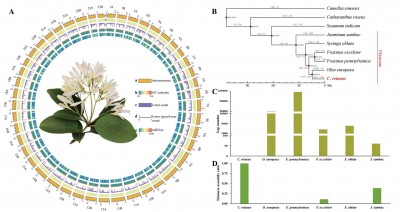Lifestyle
Researchers Decode Gene Behind “April Snow” Tree’s Unique Blooms

The ornamental appeal of the “April Snow” tree, scientifically known as Chionanthus retusus, has gained new insights thanks to a groundbreaking study revealing the complete genome sequence of this plant. Researchers successfully produced the first telomere-to-telomere, gap-free genome, which uncovers the genetic mechanisms that shape its distinctive floral characteristics.
Understanding flower shape is vital for enhancing the aesthetic value of ornamental plants. The new research identifies a specific gene, CrAUX/IAA20, as a crucial regulator of petal morphology. This gene influences petal vasculature, determining whether the petals maintain a flat shape, curl inward, or develop a spiral formation. By correlating gene expression patterns with the structural organization of veins in the petals, scientists have provided a molecular explanation for the diversity observed in floral forms.
Implications for Breeding and Ornamental Traits
The findings from this study not only enhance our understanding of the genetic basis of flower morphology but also open avenues for the selective breeding of new ornamental varieties within the Oleaceae family. With the knowledge of how the CrAUX/IAA20 gene operates, plant breeders can potentially improve flower traits with greater precision, tailoring new varieties to meet specific aesthetic preferences.
This research highlights the importance of genetic regulation in the field of ornamental horticulture. By identifying the mechanisms behind petal shape, scientists can contribute to the development of plants that are more appealing to consumers, potentially boosting market demand for such varieties. The work emphasizes how molecular genetics can intersect with commercial interests in horticulture, paving the way for innovations in plant breeding.
The study underscores the critical role of genetics in enhancing ornamental traits, which can significantly impact the economy of the horticultural industry. As consumer preferences shift towards unique and visually striking plants, the ability to manipulate genetic traits will be essential for growers aiming to remain competitive.
In conclusion, the comprehensive genome of Chionanthus retusus serves as a vital resource for understanding the underlying genetic factors that contribute to the floral elegance of this tree. The insights gained from the research not only enrich scientific knowledge but also hold substantial implications for the future of ornamental plant breeding.
-

 Technology5 months ago
Technology5 months agoDiscover the Top 10 Calorie Counting Apps of 2025
-

 Health2 months ago
Health2 months agoBella Hadid Shares Health Update After Treatment for Lyme Disease
-

 Health3 months ago
Health3 months agoErin Bates Shares Recovery Update Following Sepsis Complications
-

 Technology4 months ago
Technology4 months agoDiscover How to Reverse Image Search Using ChatGPT Effortlessly
-

 Technology1 month ago
Technology1 month agoDiscover 2025’s Top GPUs for Exceptional 4K Gaming Performance
-

 Technology2 months ago
Technology2 months agoElectric Moto Influencer Surronster Arrested in Tijuana
-

 Technology5 months ago
Technology5 months agoMeta Initiates $60B AI Data Center Expansion, Starting in Ohio
-

 Technology5 months ago
Technology5 months agoRecovering a Suspended TikTok Account: A Step-by-Step Guide
-

 Health4 months ago
Health4 months agoTested: Rab Firewall Mountain Jacket Survives Harsh Conditions
-

 Lifestyle5 months ago
Lifestyle5 months agoBelton Family Reunites After Daughter Survives Hill Country Floods
-

 Technology4 months ago
Technology4 months agoHarmonic Launches AI Chatbot App to Transform Mathematical Reasoning
-

 Technology3 months ago
Technology3 months agoUncovering the Top Five Most Challenging Motorcycles to Ride









